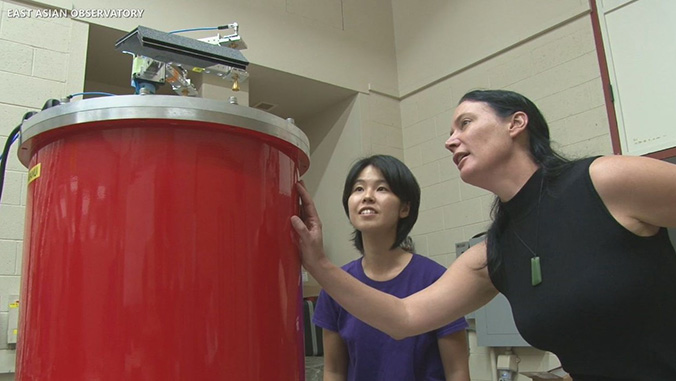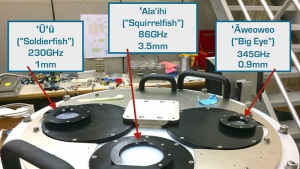
A new instrument to be installed at the James Clerk Maxwell Telescope on Maunakea has been named Nāmakanui by renowned Hawaiian language expert Larry Kimura, an associate professor of Hawaiian language and Hawaiian studies at the University of Hawaiʻi at Hilo. Nāmakanui (The Big Eyes) will allow astronomers to seek out the coldest gas and dust in the universe opening a new window into the universe from Maunakea.
The new instrument is comprised of three cameras, each studying the universe at a different wavelength or color of light. The name Nāmakanui, The Big Eyes, refers to the three individual receivers that make up the instrument, each of which Kimura named after red-colored, big-eyed species of nocturnal fish: ʻŪʻū, ʻĀweoweo and ʻAlaʻihi.
East Asian Observatory operates the James Clerk Maxwell Telescope from a base facility in Hilo, where Kimura saw the instrument in person when it arrived.
Red big-eyed fish

“With today’s telescopes we have much more to see and learn about the lani, our heavens,” Kimura said. “So when Jessica Dempsey [deputy director of the East Asian Observatory] asked if I could name this new instrument to probe the darkest places in space, it took me into the ocean, where, in the darkness of night, various sea life are active, such as our nocturnal red-hued fish—the ʻūʻū, ʻalaʻihi and ʻāweoweo—that have large eyes to help them see in that darkness.”
He added, “Jessica had to make a special request that this instrument be painted red to represent these red big-eyed fish.”
According to a release from the observatory, Nāmakanui will peer into the darkest and coldest regions of space to help astronomers hunt for objects they currently are unable to see.
“We love the names (Professor) Kimura chose—how they describe the species of fish in Hawaiian waters that come out in the darkness of night to hunt with their large sensitive eyes,” Dempsey said.
Hawaiian naming

The Hawaiian naming of telescope instruments and astronomical findings is part of a larger initiative to strengthen culture and science partnerships. A new program out of ʻImiloa Astronomy Center of Hawaiʻi, A Hua He Inoa, is the first of its kind in the world that weaves traditional indigenous practices into the process of officially naming astronomical discoveries. Hawaiian speaking students in the program have named two asteroids in the solar system, Kamoʻoalewa and Kaʻepaokaʻawela.
“It’s a wonderful opportunity to carry on the naming in Hawaiian, objects in the sky that our Hawaiian ancestors observed only with their eyes, unaided by any modern instruments,” Kimura said.
Nāmakanui’s mission

When operational, the instrument will be cooled to just a few degrees above absolute zero, in order to be sensitive to the faint radiation emitted from cold, star forming gases such as carbon monoxide, and other complex molecules which coalesce in our galaxy and beyond.
The observatory team plans to use Nāmakanui next year for the next experiment with the Event Horizon Telescope as the world-wide collection of telescopes hunt for the next image of a black hole. The observatory and its neighbor on the summit of Maunakea, the Submillimeter Array, participated in the last Event Horizon Telescope experiment, which led to the immense achievement of imaging Pōwehi, the black hole at the center of the massive M87 galaxy, announced earlier this year. Kimura also named Pōwehi.
In the next hunt, Nāmakanui’s detectors will bring four times more sensitive measurements to the experiment, giving astronomers an even greater chance of imaging these mysterious monsters at the centers of the galaxy and beyond.

